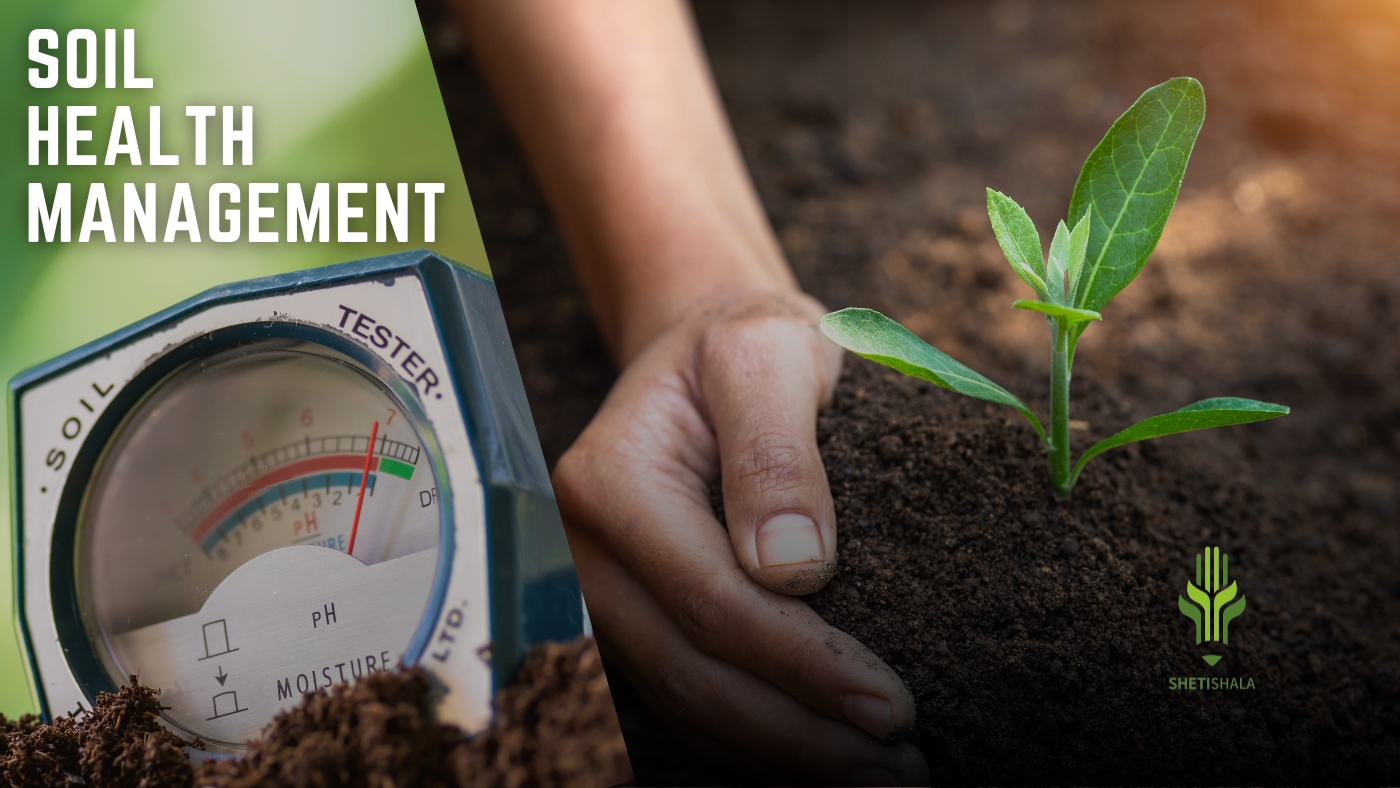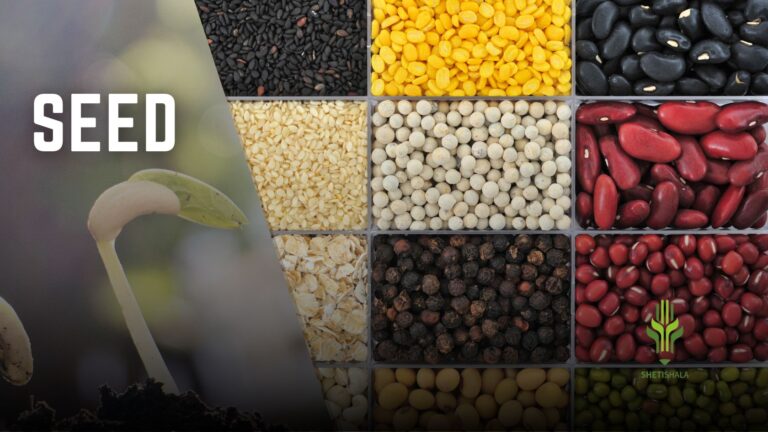Introduction
Soil health management is crucial for sustaining agricultural productivity and ensuring food security in a world facing increasing environmental challenges. This topic explores essential techniques for maintaining soil fertility, effective soil testing methods, and the role of organic fertilizers in promoting sustainable agriculture practices.
Maintaining soil fertility involves practices that preserve and enhance the soil’s physical, chemical, and biological properties. Farmers and agri-entrepreneurs employ various techniques such as crop rotation, cover cropping, and integrated nutrient management to optimize soil health. Soil testing plays a pivotal role in understanding nutrient deficiencies and pH levels, guiding farmers in applying targeted fertilization strategies.
Organic fertilizers, derived from natural sources such as compost, animal manure, and biofertilizers, offer sustainable alternatives to synthetic fertilizers. They enrich the soil with essential nutrients, improve soil structure, and foster microbial activity, thereby promoting long-term soil health and minimizing environmental impact.
By integrating these practices and innovations, agri-entrepreneurs can enhance soil fertility, increase crop yields sustainably, and contribute to global efforts towards agricultural sustainability and food system resilience.

Soil Health Management: Techniques for Maintaining Soil Fertility
Soil health management is a fundamental aspect of sustainable agriculture, essential for maintaining soil fertility, enhancing crop productivity, and ensuring long-term environmental sustainability. This comprehensive exploration delves into the critical techniques, principles, and innovations in soil health management that agri-entrepreneurs, farmers, and stakeholders employ to preserve and enhance soil fertility.
Understanding Soil Fertility
Soil fertility refers to the soil’s ability to provide essential nutrients to plants in adequate quantities and proportions for optimal growth and development. It encompasses the soil’s physical, chemical, and biological properties that collectively influence plant nutrient availability, water retention, root development, and overall soil productivity.
Importance of Soil Health Management
Healthy soils are the foundation of agricultural productivity and sustainability. They support diverse ecosystems, promote nutrient cycling, improve water infiltration and retention, and mitigate environmental degradation such as erosion and nutrient leaching. Effective soil health management practices not only optimize agricultural yields but also contribute to climate resilience, biodiversity conservation, and sustainable land use practices.
Techniques for Maintaining Soil Fertility
Achieving and maintaining soil fertility involves a combination of agricultural practices, soil amendments, and management strategies designed to enhance soil structure, nutrient availability, and biological activity. Key techniques include:
1. Crop Rotation and Diversification
Crop rotation involves alternating different crops in sequential seasons or years on the same piece of land. It helps break pest cycles, improve soil structure, and balance nutrient uptake in the soil. Diversification, such as intercropping or polyculture systems, further enhances soil health by promoting biodiversity, reducing soil erosion, and improving nutrient cycling.
2. Cover Cropping and Green Manure

Cover cropping involves planting non-commercial crops during fallow periods or between cash crops to cover the soil surface. Cover crops protect against erosion, suppress weeds, and add organic matter to the soil when incorporated. Green manure crops, such as legumes, fix atmospheric nitrogen into the soil, improving nitrogen availability for subsequent crops.
3. Organic Matter Management
Organic matter, derived from plant and animal residues, plays a vital role in maintaining soil fertility. Incorporating organic matter through composting, mulching, or crop residues improves soil structure, water holding capacity, and microbial activity. It also releases nutrients gradually, reducing the need for synthetic fertilizers and enhancing nutrient cycling within the soil ecosystem.
4. Integrated Nutrient Management (INM)
INM integrates organic and inorganic nutrient sources to optimize nutrient availability and crop uptake while minimizing environmental impacts. It combines the use of organic fertilizers, such as compost and biofertilizers, with judicious application of synthetic fertilizers based on soil nutrient testing and crop nutrient requirements. INM promotes balanced nutrient ratios, reduces nutrient runoff, and enhances soil fertility sustainably.
5. Conservation Tillage and Soil Erosion Control
Conservation tillage practices, such as no-till or reduced tillage systems, minimize soil disturbance and maintain crop residues on the soil surface. These practices improve soil structure, reduce erosion, conserve soil moisture, and preserve soil organic matter. By reducing soil erosion, conservation tillage enhances nutrient retention and promotes long-term soil fertility.
Soil Testing Methods
Accurate soil testing is essential for assessing soil fertility status, identifying nutrient deficiencies or imbalances, and guiding fertilizer applications. Soil testing methods include:

Basic Soil Tests:
Measure soil pH, nutrient levels (nitrogen, phosphorus, potassium), and organic matter content using laboratory analysis.
Advanced Soil Tests:
Assess micronutrient levels, cation exchange capacity (CEC), soil texture, and other soil physical properties to provide comprehensive soil fertility profiles.
On-Farm Testing Tools:
Portable soil testing kits and sensors allow farmers to conduct rapid on-site assessments of soil pH, nutrient availability, and moisture content, facilitating timely management decisions.
Effective soil testing enables agri-entrepreneurs to customize nutrient management strategies, optimize fertilizer applications, and maintain soil health for sustainable crop production.
Challenges in Soil Health Management
Despite the benefits and advancements in soil health management practices, agri-entrepreneurs face several challenges that hinder effective soil fertility maintenance:
Financial Constraints:
Investing in soil health management practices, such as cover cropping or organic inputs, may require upfront costs that some farmers find prohibitive without adequate financial support or incentives.
Knowledge and Awareness:
Limited access to information, training, and technical support on soil health management practices can impede farmers’ adoption of sustainable soil management strategies.
Market Dynamics:
Market pressures and price fluctuations may prioritize short-term economic gains over long-term soil health benefits, influencing farmers’ decisions on soil management practices.
Climate Change Impacts:
Increasing climate variability and extreme weather events pose challenges to soil health, affecting soil moisture, nutrient availability, and crop resilience.
Soil Testing Methods: Enhancing Agricultural Productivity through Precision Soil Management
Soil testing is a foundational practice in agriculture, essential for assessing soil fertility, nutrient availability, pH levels, and other key parameters critical to crop growth and productivity. This extensive exploration delves into the significance of soil testing methods, their applications across different agricultural contexts, and the advancements shaping the future of precision soil management.
Importance of Soil Testing
Soil testing serves as a crucial tool for farmers, agri-entrepreneurs, and agricultural professionals to make informed decisions about nutrient management, fertilizer applications, and soil health improvement strategies. By analyzing soil samples, farmers can identify nutrient deficiencies or imbalances, determine optimal fertilizer rates, and tailor agricultural practices to maximize crop yields while minimizing environmental impacts.

Objectives of Soil Testing
The primary objectives of soil testing include:
Nutrient Assessment:
Determine the availability of essential nutrients such as nitrogen (N), phosphorus (P), potassium (K), sulfur (S), calcium (Ca), magnesium (Mg), and micronutrients (e.g., zinc, iron) in the soil.
pH Measurement:
Assess soil acidity or alkalinity (pH levels) to understand its influence on nutrient availability and crop growth.
Organic Matter Content:
Estimate the percentage of organic matter in the soil, which influences soil structure, water retention, and nutrient cycling capabilities.
Texture and Composition:
Determine soil texture (sand, silt, clay) and composition to evaluate water infiltration, drainage, and root penetration characteristics.
Methods of Soil Testing
Soil testing methods encompass a range of techniques and approaches, each offering unique insights into soil properties and fertility status. These methods include:
1. Basic Soil Tests
Basic soil tests involve laboratory analysis of soil samples to assess fundamental soil parameters:
Nutrient Analysis:
Measures nutrient levels (e.g., N, P, K) using chemical extraction methods such as Mehlich-3, Bray, Olsen, or ammonium acetate.
pH Measurement:
Determines soil pH using pH meters or colorimetric methods to assess soil acidity or alkalinity.

Organic Matter Analysis:
Estimates organic matter content through loss-on-ignition or Walkley-Black methods, indicating soil fertility and carbon sequestration potential.
Advanced Soil Tests
Advanced soil tests provide more detailed information on soil properties and fertility characteristics:
Micronutrient Analysis:
Quantifies micronutrient levels (e.g., iron, zinc, manganese) using specialized extraction techniques such as diethylene triamine penta acetic acid (DTPA) or ethylenediaminetetraacetic acid (EDTA).
Cation Exchange Capacity (CEC):
Measures the soil’s ability to retain and exchange positively charged ions (e.g., Ca, Mg, K) using ammonium acetate extraction, indicating nutrient holding capacity and soil fertility potential.
Texture and Particle Size Analysis:
Determines soil texture (sand, silt, clay) and particle size distribution using sedimentation or hydrometer methods, influencing water retention, drainage, and root development.
On-Farm Soil Testing Tools
On-farm soil testing tools and kits offer rapid, on-site assessments of soil properties:
Portable pH Meters:
Measure soil pH instantly using electronic pH meters or colorimetric test strips, providing real-time pH readings for immediate management decisions.

Electrical Conductivity (EC) Meters:
Assess soil salinity and nutrient availability by measuring soil electrical conductivity, indicating soil fertility and irrigation management requirements.
Soil Moisture Sensors:
Monitor soil moisture levels in real-time to optimize irrigation scheduling, improve water use efficiency, and prevent water stress in crops.
Applications of Soil Testing
Soil testing methods find extensive applications across agricultural practices, research, and land management strategies:
Precision Agriculture:
Integrates soil testing data with geographic information systems (GIS) and global positioning systems (GPS) to create soil fertility maps, guide variable rate fertilizer applications, and optimize farm inputs based on spatial variability.
Nutrient Management Planning:
Develops customized nutrient management plans (NMPs) based on soil test results to optimize fertilizer rates, minimize nutrient losses, and enhance crop nutrient uptake efficiency.
Environmental Monitoring:
Assess soil health indicators, track changes in soil properties over time, and evaluate the effectiveness of soil conservation practices and sustainable land management strategies.
Regulatory Compliance:
Meets regulatory requirements for nutrient management, environmental stewardship, and soil conservation practices mandated by agricultural policies and conservation programs.
Advancements in Soil Testing Technologies
Recent advancements in soil testing technologies and methodologies have revolutionized precision soil management practices:
Spectroscopic Techniques:
Utilize infrared (IR) spectroscopy and near-infrared (NIR) spectroscopy to analyze soil samples rapidly and non-destructively, providing comprehensive soil fertility profiles and nutrient content analysis.
DNA Sequencing and Microbial Analysis:
Assess soil microbial diversity, functional capabilities, and ecosystem services using next-generation sequencing (NGS) technologies, enhancing understanding of soil-plant-microbe interactions and nutrient cycling processes.
Remote Sensing and Digital Soil Mapping:
Employ remote sensing imagery, hyperspectral imaging, and electromagnetic induction (EMI) techniques to map soil properties, predict soil fertility variations, and support precision agriculture applications.
Challenges and Considerations
Despite advancements, challenges in soil testing persist, including:
Cost and Accessibility:
High costs associated with laboratory tests, equipment, and technical expertise may limit access for small-scale farmers and resource-constrained regions.
Standardization and Calibration:
Variability in soil testing methodologies, calibration standards, and interpretation guidelines may lead to inconsistent results and management recommendations.
Interpretation and Decision-Making:
Complex data interpretation, integration with agronomic knowledge, and translating soil test results into actionable management decisions pose challenges for farmers and agricultural advisors.
Future Directions and Opportunities
Future developments in soil testing aim to address these challenges and capitalize on emerging opportunities:
Digital Agriculture Platforms:
Integrate soil testing data with farm management software, IoT devices, and cloud-based analytics platforms to enhance data-driven decision-making, optimize resource use efficiency, and support sustainable farming practices.
Innovative Sensors and Technologies:
Develop portable, low-cost soil testing kits, smartphone applications, and sensor networks to democratize access to soil health information and empower farmers with real-time, actionable insights.
Big Data and AI Applications:
Apply artificial intelligence (AI) algorithms, machine learning models, and predictive analytics to analyze large-scale soil datasets, predict soil fertility trends, and recommend adaptive management strategies.
The Use of Organic Fertilizers for Soil Health Management: Enhancing Sustainability in Agriculture
Organic fertilizers play a crucial role in modern agriculture, offering sustainable alternatives to synthetic fertilizers while promoting soil health, biodiversity, and long-term agricultural sustainability. This comprehensive exploration delves into the significance of organic fertilizers, their benefits, challenges, and innovative applications in soil health management practices worldwide.

Importance of Organic Fertilizers
Organic fertilizers derive from natural sources such as plant residues, animal manure, compost, and biofertilizers. Unlike synthetic fertilizers, which are chemically synthesized, organic fertilizers contribute to soil fertility and nutrient cycling without compromising soil structure, microbial diversity, or environmental quality. The importance of organic fertilizers in sustainable agriculture is underscored by their role in:
Enhancing Soil Fertility: Organic fertilizers enrich the soil with essential nutrients (e.g., nitrogen, phosphorus, potassium) and micronutrients, promoting balanced nutrient availability for plant uptake and improving soil fertility over time.
Improving Soil Structure: Organic matter in fertilizers enhances soil aggregation, porosity, and water-holding capacity, facilitating root growth, nutrient absorption, and soil aeration.
Supporting Microbial Activity: Organic fertilizers stimulate beneficial microbial populations in the soil, contributing to nutrient cycling, organic matter decomposition, disease suppression, and overall soil health.
Types of Organic Fertilizers
Organic fertilizers encompass a diverse range of materials and formulations, each offering unique nutrient profiles, application methods, and benefits for soil health management:
1. Animal-Based Organic Fertilizers
Manure: Animal manure, such as cow, poultry, or pig manure, is a valuable source of nitrogen, phosphorus, potassium, and organic matter. It improves soil fertility, enhances microbial activity, and provides slow-release nutrients for sustained plant growth.
Bone Meal: Derived from animal bones, bone meal is rich in phosphorus and calcium, essential for root development, flowering, and fruiting stages of plant growth.
2. Plant-Based Organic Fertilizers
Compost: Compost is produced from decomposed organic matter, including kitchen scraps, yard waste, and agricultural residues. It enhances soil structure, nutrient availability, and microbial diversity, supporting healthy plant growth and reducing nutrient leaching.
Green Manure: Leguminous cover crops, such as clover or alfalfa, are grown and incorporated into the soil to improve nitrogen fixation, soil organic matter content, and fertility without synthetic inputs.
3. Biofertilizers
Rhizobium and Mycorrhizal Inoculants: Biofertilizers contain beneficial microorganisms, such as nitrogen-fixing bacteria (Rhizobium) and mycorrhizal fungi, which form symbiotic relationships with plant roots. They enhance nutrient uptake efficiency, improve soil structure, and promote plant growth under diverse environmental conditions.
Algal Fertilizers: Derived from marine algae, algal fertilizers enrich the soil with trace minerals, growth hormones, and bioactive compounds that enhance plant resilience, nutrient absorption, and stress tolerance.

Benefits of Organic Fertilizers for Soil Health Management
Organic fertilizers offer several advantages over synthetic counterparts, contributing to sustainable soil management practices and agricultural productivity:
1. Environmental Sustainability
Reduced Environmental Impact:
Organic fertilizers release nutrients gradually, minimizing nutrient runoff, soil erosion, and water pollution compared to soluble synthetic fertilizers.
Carbon Sequestration:
Organic matter in fertilizers enhances soil carbon storage, mitigating climate change impacts and promoting carbon sequestration in agricultural soils.
2. Soil Health and Fertility
Improved Soil Structure:
Organic matter enhances soil aggregation, water infiltration, and root penetration, improving soil tilth and reducing compaction.
Microbial Diversity:
Organic fertilizers support diverse microbial communities that contribute to nutrient cycling, disease suppression, and soil ecosystem resilience.
3. Crop Nutrition and Yield
Balanced Nutrient Supply:
Organic fertilizers provide a balanced nutrient supply, promoting healthy plant growth, flowering, fruiting, and higher crop yields over successive growing seasons.
Long-Term Benefits:
Continuous application of organic fertilizers improves soil fertility, reduces dependency on external inputs, and supports sustainable crop production systems.
Challenges in Using Organic Fertilizers
Despite their benefits, organic fertilizers present challenges that require careful management and strategic application:
1. Nutrient Availability and Timing
Slow Release: Organic fertilizers release nutrients slowly as they decompose, requiring timely application to meet crop nutrient demands during different growth stages.
Nutrient Imbalances: Imbalanced nutrient ratios in organic fertilizers may necessitate supplementary applications or nutrient management adjustments to optimize crop nutrition.
2. Quality and Consistency
Variability: The nutrient content of organic fertilizers can vary based on raw material composition, decomposition rates, and composting conditions, affecting nutrient availability and application uniformity.
3. Application and Logistics
Handling and Storage: Organic fertilizers require proper handling, storage, and application techniques to maximize nutrient retention, minimize odor, and ensure safety for farm workers and neighboring communities.
4. Regulatory Compliance
Organic Certification: Organic fertilizers used in certified organic agriculture must comply with stringent regulations regarding raw material sourcing, processing methods, and allowable inputs.
Innovations and Future Directions
Advancements in organic fertilizer technologies and management practices are paving the way for sustainable soil health management and agricultural innovation:
Precision Application Technologies: Develop precision farming tools, IoT devices, and sensor technologies to optimize organic fertilizer application rates, timing, and spatial distribution based on soil nutrient requirements and crop growth stages.
Biological Amendments: Explore biochar, microbial inoculants, and biostimulants as novel organic amendments that enhance soil fertility, improve nutrient use efficiency, and promote plant health in diverse agroecosystems.
Circular Economy Initiatives: Implement circular economy principles to recycle agricultural waste and by-products into value-added organic fertilizers, reducing waste generation and enhancing resource efficiency.

Conclusion
In conclusion, effective soil health management is essential for sustainable agriculture, encompassing techniques like crop rotation, cover cropping, and integrated nutrient management. Soil testing methods provide critical insights into soil fertility, guiding optimal fertilizer use. Meanwhile, organic fertilizers play a pivotal role in enhancing soil structure, nutrient availability, and microbial activity sustainably. By integrating these practices, agri-entrepreneurs can foster resilient soils, improve crop yields, and contribute to long-term environmental stewardship in agriculture. Embracing these holistic approaches ensures productive farmlands while safeguarding natural resources for future generations
for more information about soil conservation you can check our blog (click here)




